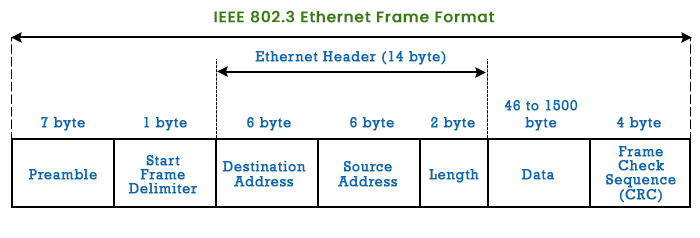Ethernet Frame Format
The IEEE 802.3 standard defines the fundamental frame format that is necessary for all MAC implementations. However, the core functionality of the protocol is being extended by several optional forms.
Preamble and SFD, which operate at the physical layer, begin an Ethernet frame. The packet's payload follows the Ethernet header, which includes the MAC addresses for the source and destination. CRC, the final field, is utilized to find errors. Let's now examine each section of the fundamental frame format.
- PREAMBLE - Ethernet frames begin with a 7-byte. This is a sequence of alternate 0s and 1s that denotes the beginning of the frame and enables bit synchronization between the sender and receiver. PRE (Preamble) was initially developed to accommodate the loss of a few bits as a result of signal delays. However, the frame bits in high-speed Ethernet today are protected without the need for a preamble.
Prior to the actual frame beginning, PRE (Preamble) alerts the receiver that a frame is about to start and enables the receiver to lock onto the data stream.
- Start of frame Delimiter (SFD) - This 1-byte field is always set to 10101011. The destination address is the next set of bits that will begin the frame, as indicated by SFD. The preamble is frequently referred to as 8 Bytes since SFD is sometimes seen as a component of PRE. The SFD notifies the station or stations that synchronization is now impossible.
- Destination Address - This 6-Byte element contains the MAC address of the device for which the data is intended.
- Source Address - This 6-byte element contains the source machine's MAC address. Since Source Address is always a unique address (Unicast), 0 is always the least significant bit of the first byte.
- Length - A 2-Byte field called Length represents the size of an Ethernet frame as a whole. Due to some inherent constraints of Ethernet, this 16-bit field can store length values from 0 to 65534, but length values greater than 1500 are not permitted.
- Data - This area, sometimes referred to as the Payload, is where the real data is placed. If Internet Protocol is utilised via Ethernet, both the IP header and data will be placed here. The longest possible piece of data might be 1500 bytes long. If the data length is less than the minimum length, which is 46 bytes, padding 0's are appended to make up the difference.
- Cyclic Redundancy Check (CRC) - CRC is a field of 4 bytes. The data in this field is a 32-bit hash code created using the fields for the destination address, source address, length, and data. Data is damaged if the checksum calculated by the destination differs from the checksum value supplied.
Note- Ethernet IEEE 802.3 frames range in size from 64 to 1518 bytes, including data length (46 to 1500 bytes),
Complete illustration of Extended Ethernet Frame (Ethernet II frame):
Below, a thorough explanation of the IEEE 802.3 basic frame format is provided. Let's look at the expanded Ethernet frame header, which allows for a payload of even more than 1500 bytes.

DA [Destination MAC Address]: 6 bytes
SA [Source MAC Address]: 6 bytes
Type [0x8870 (Ethertype)]: 2 bytes
DSAP [802.2 Destination Service Access Point]: 1 byte
SSAP [802.2 Source Service Access Point]: 1 byte
Ctrl [802.2 Control Field]: 1 byte
Data [Protocol Data]: > 46 bytes
FCS [Frame Checksum]: 4 bytes
Although the Ethernet II frame lacks a length field, the network interface knows the frame length because it accepts the frame.
Advantages of using Ethernet:
- Simple to implement
- Maintenance is Easy
- Less cost
Flaws of Ethernet:
- It can't be applied in real-time situations. Data delivery within a certain time frame is necessary for real-time applications. Due to the high likelihood of collisions, Ethernet is unreliable. The delivery of the data to its destination may be delayed due to an increased number of collisions.
- Applications requiring interaction cannot be utilized with it. Even extremely little amounts of data must be delivered for interactive apps like chatting. The minimum data length required by Ethernet is 46 bytes.
- It is incompatible with client-server applications. Applications that use client-server architecture demand that the server is prioritised over the client. Priorities cannot be set in Ethernet.
|

 For Videos Join Our Youtube Channel: Join Now
For Videos Join Our Youtube Channel: Join Now










